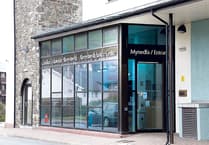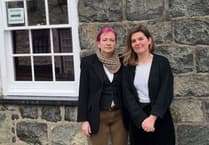Eighty years after the start of the Second World War triggered a mass relocation of people and organisations to Wales, residents and visitors can discover many evacuation stories on the spot using their mobile phones.
Children were not the only evacuees to move to Wales to escape the threat of bombing. Government departments were also relocated – including the Inland Revenue to Llandudno and Ministry of Food to Colwyn Bay – along with companies doing important war work.
Military establishments were also moved, such as the experimental firing range which transferred from Kent to Pendine. Ships of the displaced Dutch navy operated out of Holyhead.
Priceless artworks were moved from London and Merseyside to Aberystwyth, Bangor, Blaenau Ffestiniog and Conwy, and the BBC aired some of its most popular radio shows from north Wales.
The HistoryPoints project has created QR codes for display at more than 40 locations across Wales which are related to the evacuation story.
Anyone can scan the codes with a smartphone to view a web page which explains each place’s history, including its wartime use for evacuation. Each page has an ‘Evacuation to Wales in WW2’ badge, which readers can click to discover the other locations and stories featured.
Each location is mapped, and all of the information can be viewed by browsing the HistoryPoints.org website.
Rhodri Clark, editor of HistoryPoints.org, said: “Our project began to highlight the surprising evacuation histories of familiar places back in 2012. We have featured many more locations since then.
“We hope that our coverage – compiled with the help of many contributing historians – helps today’s residents and visitors to appreciate the role Wales played as a shelter for so many people, objects and establishments.”
Among the contributors is Adrian Hughes, of the Home Front Museum in Llandudno.
He said: “Many people associate wartime evacuation with children being relocated, and there were certainly many thousands of child evacuees in Wales in the early years of the war. Not so many people realise that the Inland Revenue operated from some of Llandudno’s most iconic hotels, or that Belgian and Dutch diamond polishers in Colwyn Bay and Bangor helped Britain pay for vital imports.”
The collection of evacuation stories also covers refugees from mainland Europe including Walter Salamon, founder of Wally’s Delicatessen in Cardiff. His family had fled to Britain after the Gestapo sent them to a Viennese ghetto.
The collection also highlights education of evacuated children and young people. Entire schools were relocated from England to Wales.
Thousands of evacuees were taught in local schools and chapels, and University College London set up science labs in a Bangor shop for some of its displaced students.
QR codes in Llandudno and Llanrwst reveal the locations of secret wartime safe houses where MI5 would have evacuated double agents had the Nazis invaded Britain.




